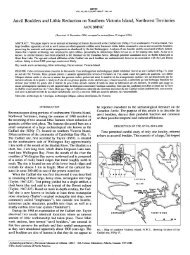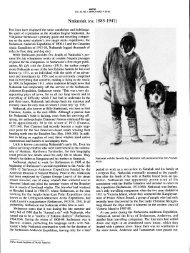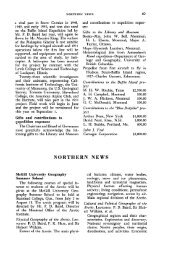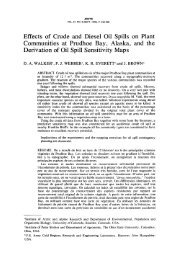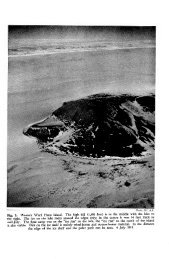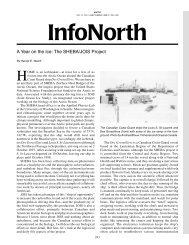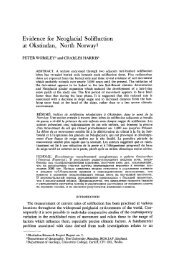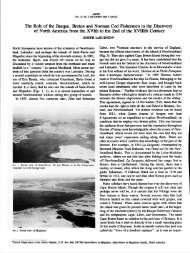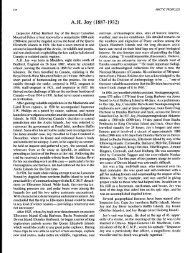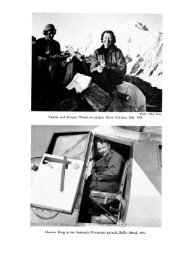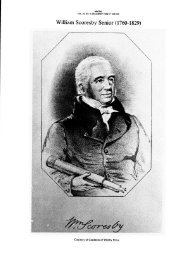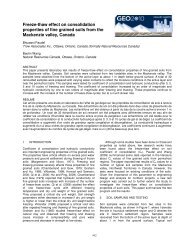NOTES ON THE NUNAMIUT ESKIMO AND MAMMALS OF ... - arctic
NOTES ON THE NUNAMIUT ESKIMO AND MAMMALS OF ... - arctic
NOTES ON THE NUNAMIUT ESKIMO AND MAMMALS OF ... - arctic
Create successful ePaper yourself
Turn your PDF publications into a flip-book with our unique Google optimized e-Paper software.
182 <strong>THE</strong> <strong>NUNAMIUT</strong> <strong>ESKIMO</strong> <strong>AND</strong> <strong>MAMMALS</strong> <strong>OF</strong> <strong>THE</strong> ANAKTUVUK PASS REGI<strong>ON</strong><br />
Clethrionomys rutilus dawsoni (Merriam) . Avingak. Red-backed vole.<br />
The red-backed vole was the second most common mouse-like rodent in<br />
this region. It was trapped most often in the lower country, particularly in<br />
the main valley, but it was also taken at altitudes up to 3,000 feet. This vole<br />
was found in a variety of habitats, but apparently preferred Salix and Salix-<br />
Betula nana communities where the ground was covered with dense moss. I<br />
collected a few specimens at Umiat on a dry slope heavily grown to Salix spp.<br />
and Alnus crispa, above a dense growth of mosses and lichens.<br />
The burrows of the red-backed vole were common in moss hummocks<br />
around the base of willows, particularly in the spring-area at Tulugak Lake.<br />
Small round burrows were found among limestone talus overgrown with<br />
Cassiope, near the top of a low mountain at an altitude of more than 3,500 feet.<br />
Characteristic fecal deposits were noted at the enrrance to the burrows.<br />
In the winter, tracks showed that this vole fed on wolf-kills and other<br />
available carcasses, but no other observations were made on their feeding habits.<br />
Red-backed voles were readily trapped in the winter, in contrast to the<br />
other species of microtine rodents in this region which, with the exception<br />
Dicrostonyx, remain under the snow.<br />
of<br />
As is characteristic of voles of the genus Clethrionornys, the Brooks Range<br />
specimens show much variation in colour, ranging from a buffy-brown to a<br />
striking ochraceous-orange. Part of this variation is, of course, seasonal, but<br />
in general colour has little taxonomic value in this group (see Rausch, 1950b).<br />
The maximum weight of this animal rarely exceeds 30 grams.<br />
More than 100 specimens have been collected from the Anaktuvuk Pass<br />
region, but relatively little information was obtained on breeding habits.<br />
Breeding apparently begins in May and has stopped by early September. More<br />
than 70 animals have been collected in the Savioyok valley, and a few at Umiat.<br />
One specimen was taken during July 1951 at the south end of Lake Schrader<br />
in the Romanzof Mountains, and a series was obtained at Arctic Village.<br />
Microtus oeconomus macfarlani Merriam. Auingak. Tundra vole.<br />
The tundra vole has been relatively uncommon during the time of these<br />
observations, and only 65 animals have been obtained. The majority was taken<br />
near the spring-area of Tulugak Lake, but a fair series in winter pelage was<br />
trapped during the fall of 1950, just south of the divide. Two specimens were<br />
taken in the timbered Savioyok valley; one was taken on the tundra just north<br />
of the mountains, and a few were found frozen in an Eskimo cache on<br />
the Killik River. The tundra vole is distributed over much of <strong>arctic</strong> Alaskal.<br />
A few specimens were obtained at Umiat and at Bettles, near the mouth of<br />
John River; 5 were taken at Lake Schrader during July 1951, and a good series<br />
was collected at Arctic Village. Hall (1929) reported this species from a<br />
river, possibly the Meade, about fifty miles south of Barrow.<br />
During these observations the tundra vole appears to have occurred in<br />
restricted colonies only. It prefers areas grown to sedge (Carex spp.), or<br />
various grasses. One specimen was taken in a Carex aquatilis-C. Bigelowii<br />
""<br />
1We have also collected large series from regions south of the Brooks Range.



